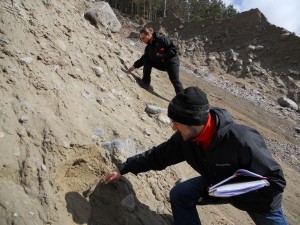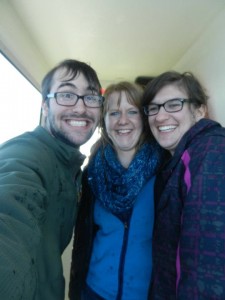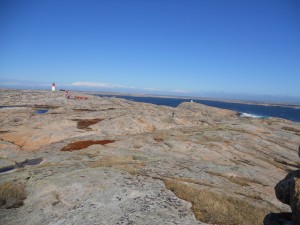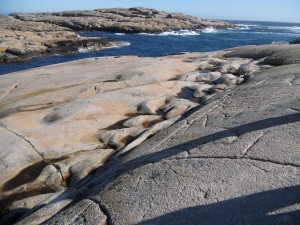After a day of exploring the city of Göteborg, we began our first day “out in the field” of Geology with Mark on Tuesday. Mark taught at Gustavus for many years before he moved to Sweden in 2003 and began teaching at the University in Göteborg, and he is now head of his department there. He was thrilled to be around Gusties again—we were very American in the fact that we were boisterous and inquisitive, as opposed to the reserved and more mature Swedish counterparts that Mark is now used to, so he appreciated having us around. We got up early to check out of our hostel, and then packed up the large van and smaller car that would essentially become our home for the next four days. The day started out rainy and cold—not the best conditions for being outside all day. Our first stop was on top of a cliff in the harsh wind, and everyone was visibly shivering when Mark decided to move the group to a more secluded location. We were expected to keep field notes for the duration of the trip, which proved very interesting when the wind picked up, so overall it wasn’t the most ideal start to our weeklong field trip.
It warmed up at our second stop, which involved visiting a till site, which was essentially a large hill with many different kinds of rocks deposited by the glacier that went through the area. We were encouraged to sift through the side of the hill and examine how the rocks were of very different varieties and sizes because they were dragged underneath the glacier. Mark then gave us a explanation about drumlins, which are fairly rare to the area. Drumlins are elongated hills formed by the ice of glaciers, and they are primarily composed of till. Having no geological background whatsoever, I found it extremely interesting to learn about how influential glaciers were to shaping the landscape, not only at this site, but many others. Mark’s research mainly focused on glacial formations, so it was fun to hear this information from an expert in the field.
We took a ferry across a channel to go from the gneiss side to the granite side of the area, where we would be staying on an island for the night. It was my first time being on a ferry large enough for cars, so that was fun to experience. We then drove a considerable distance and took another boat to Hållö, the island on the Baltic where we would be staying. After being cooped up in the car all day long, we had an excess amount of energy on the boat that needed to come out somehow. Many of us were at the front of the boat when a huge wave came over the side and drenched us all. Of course I caught the brunt of it and got a mouthful of saltwater. A laughing attack ensued when we saw how wet we were, and several pictures were taken to document the hilarity.
Our first glimpse of the island was breathtaking—it was entirely comprised of rocks, complete with a lighthouse and a few other smaller buildings. But mostly rocks. We made the trek across the uneven surface, very thankful that we had minimal luggage. Kallie and I took advantage of our free time to explore and climb to the top of the outcrop across the island from our hostel. This proved quite challenging at times, with several gaps that had to be jumped across and unexpected pools of water, but that just made the view from the top all the more satisfying. There was a small mound of rocks piled up at the top that others had left there, and this vantage point was by far one of the most beautiful views my eyes have ever seen; I’ll let the pictures speak for themselves. We made the trek back unscathed and then we went out as a group to explore the rest of the island from a geological standpoint.

Gotta love those waves
Hållö proved to be a very windy place, so taking notes was a bit of a struggle once again, but Mark taught us a lot in the several hours we were with him. We learned about p-forms, which are very interesting depressions in the surface of the rock formed by the glacier. Scientists believe that these are eroded by pressurized mud beneath the glaciers, and each form was very unique. The entire island is made of granite, and we did quite a bit of jumping over puddles, gaps, and other things to get around to all the places Mark wanted to point out to us. We worked up quite the appetite from the outing, so we had a spaghetti dinner as a group when we got back. Since we were the only ones staying on the island, we were able to take over the whole kitchen and share a meal together.
Once dinner was over, the group decided to go watch the sunset from the edge of the island, near where Kallie and I trekked earlier. It was the perfect place to just sit and goof around as a group while witnessing nature’s true beauty. Matt thought that the sunset looked like a Christian rock album cover, and going with the geology theme, we came up with several names—“Jesus Rocks” and “Don’t Take Jesus for Granite.” We were astounded by our own wittiness on that one. We had a photo shoot commemorating this idea with each of us playing a different instrument—I took the role of playing the ever-important color instruments. We took more pictures and then headed back before the sun actually set so that we could see where we were going. We then spent the rest of the evening playing cards (no internet on the island!) and just hanging out. In my opinion, it was one of the most memorable evenings of the whole trip thus far—there is just something about being surrounded by good friends and gorgeous surroundings that makes for an absolutely perfect evening.
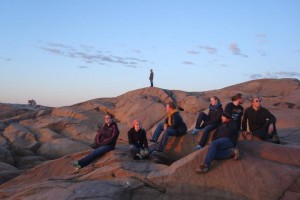
“Don’t Take Jesus for Granite”
